The start in Sweden
Record changers were first seen in Sweden in the early 1930s. The Swedish radio manufacturer Luxor claimed, in later advertising material, that they made the first record changer "on the continent". This could either refer to Scandinavia or the European continent. It seems most likely that the first European record changers were built in England, however the word "continent" might be used to exclude England from the European main continent, and then it's fully possible that Sweden was the second nation in Europe to make record changers.
Some sources claim that Luxor released their first model in 1934. They obviously didn't, although the patents might have been registered then. Luxor's automatic record changer was first introduced in the January 1936 issue of "Populär Radio".
There were, of course, record changers available long before Luxor made them. It might actually be an Australian invention from the beginning (Actually the American 1913 Autophone cylinder changer was first. The first disc changer was Australian Eric Waterworth's Salonola in 1925, but it was never mass produced. It was a bent spindle and pusher shelf changer). The first commercial disc record changers appeared in the USA and in the UK, in 1928. Both were the so-called "assembly-line" changers, because they picked up records and moved them from place to place. Some of these early types may have found their way to Sweden, but since they were expensive luxury items, there were probably very few imported. An American homepage available here will give more details of historical and technical facts.
The mechanics of the first Luxor are simple, driven by a small wheel making contact with the side of the turntable. Records are placed on the spindle and on two sidepoles. Rotating the sidepoles back and forth drops a record to the turntable The tonearm is, of course, moved out of the way while a new record is dropped, and then it moves in and sets at the edge of the new record.
When the record is finished the mechanism raises the tone arm and pulls it out of way for a new record to be dropped. When the last record is played, you will have to turn the power off. Otherwise it will be repeated over and over again, since there is no automatic stop on the earlier models. The spindle is removed to remove the records from the turntable after the stack has been played.
The drawback of this changer system is obvious, since it is capable of handling only records of the standard 10" size (25cm).
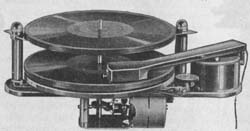
First Luxor changer GW in action.
(From Populär Radio #1 1936)
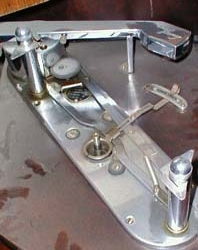
Changer mechanism shown without turntable.
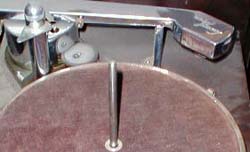
Detail of Luxor's type GW.
Note the small wheel beside the turntable that drives the mechanism.
Garrard RC 6 was built in Swindon, England and sold from the mid 1930s up to ca 1940, when war made it difficult to import and perhaps also to manufacture. This changer had an advantage compared with Luxor: It could play and change either a stack of 10" (25cm) records or a stack of 12" (30cm) records, and it shut itself off after the last record.
Records are placed on the bent spindle and on the side shelf, which is adjustable for either size. During the change cycle, the side shelf moves a bit towards the spindle, pushing the record on the bottom of the stack off of the ledge on the spindle, making it drop down on the turntable. The rest of the records in stack are held back by the shape of the spindle, allowing only one record to drop at a time.
This changer also appeared as RC 5 and RC 8. But before making these changers, Garrard made the RC 1 and RC 1A sidepole changers. These had three sidepoles spaced evenly around the records. RC 1 required setting the sidepoles for 10" or 12" (25cm or 30cm) records. RC 1A could sense the size of the records without adjustment, but could not take those sizes intermixed in a stack.
Since Luxor's changer couldn't even play 30cm records, most manufacturers used Garrard in their radiograms (phono-radio combinations) instead.

Garrard type RC 6
Another record changer that was developed in Sweden during the latter half of the 1930s ought to be mentioned here, although it wasn't designed for use in private homes. A young man, Gösta Ishammar, experimented with a mechanism for an automatic grammophone that could be used in cafés and restaurants. Since it was supposed to be coin operated, it was nothing less than what we today call a jukebox.
In 1932, at age 13, he started working on the problem. Some American jukeboxes were available in Sweden at the time, although it's not likely that there were more than a dozen or so. The number of selections on these machines was somewhere between 8 and 20. Rumors said that Ishammar was irritated about people selecting the same tunes all the time, so he decided to make his machine non selective, and to hold more records than its forerunners.
It took some years and probably several prototypes until it finally was ready for production. Around 1940, the first "Diema" was put on location. About 40 units were made, and at least 3 are known to have survived to today.
It has a rather unique changer system: There are 3 horizontal screws containing the record magazine. It can take only 10" (25cm) 78-rpm records, and the magazine holds 30 of them. The original author has never seen this changer system in action so the following description is just a good guess of its operation.
There are two screws at the bottom for the records to rest on, and one screw at the top to keep them standing upright. Depositing a coin makes all 3 screws rotate at the same time, moving all of the vertically standing records one space to the right. The record released from the screws is pushed forward along a side guide of the machine. It is then folded down onto the turntable by two metal guides that go down below the surface of the turntable, leaving the record free to be played.
Since the turntable is a lot smaller than the record size, there is room for another pair of metal guides as well. When the record is finished, these guides raise it up against the opposite side, and another guide pushes it back onto the screws and back in magazine. The record has now been turned over, so the next time it comes into playing position, the other side of it will be played.
This made Ishammar's jukebox able to play 60 different tunes before the first one was repeated again. I'm not sure about the reliability of the mechanism but it is rather sensitive to bumps.
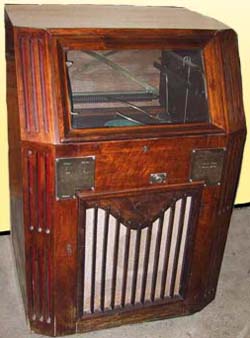
Ishammar "Diema" ca 1940.
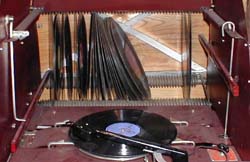
The mechanism of "Diema". It has probably been moved, so that the records in the
magazine have fallen onto each other.
Ishammar also made a selective jukebox in the early 1940s called the "Telex", and although this takes us rather far from the subject domestic record changers, the original author couldn't resist mentioning it here and showing a picture of it to the right. Only 16 of these were built. After these two jukeboxes Ishammar directed his efforts to a wide range of other amusement machines, but that is definitely another story.
The photo on the right is the Ishammar Telex" produced around 1941-42. It holds 12 selections.
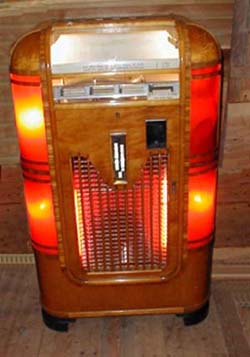
In the late 1930s Luxor was the only Swedish producer of domestic record changers. All radiogram manufacturers in Sweden except Luxor seem to have used Garrard changers. Also, the foreign manufacturers on the Swedish market favored Garrard, excepting HMV/Marconiphone, who of course used their own HMV changers.
It's possible that even the large brands like Philips and Telefunken thought it would be unnecessary to develop record changers of their own as long as Garrard specialized in changers instead of entering the radio business. At least the Swedish sales brochures for Philips, Telefunken, and Orion show radiograms with Garrard record changers included.
The War years
Then came World War II. Sweden was a neutral country during the war, but most of the radio industry had usually used Germany and the European continent as their main market, and as the main source of technical inspiration and parts. Exceptions from this were Radiola, who dealt with the British Marconi company, and Skandia, who imported radios from both England and Germany.
Luxor and Centrum used mostly American radio tubes, but other parts from Europe. For most companies, the war years became a balancing act where everybody tried to keep up their old contacts with foreign producers to get a share of what still could be imported. At the same time they were desperately seeking replacements available in Sweden.
Judging from the sales brochures, nothing much seems to have happened. There were fewer radiograms and more table models, but those radiograms advertised still included Garrard record changers (except of course Luxor's own).
Luxor made an improvement on their sidepole changer without even a note in their brochure. They moved the sidepole record supports a couple of centimeters apart so that a 12" (30cm) record could be placed on the turntable and played manually. You can't read about it anywhere, but it's obvious when comparing pictures of older changer construction with the one released in 1939.
So far, it seemed to be business as usual.

British HMV record changer from ca 1938.
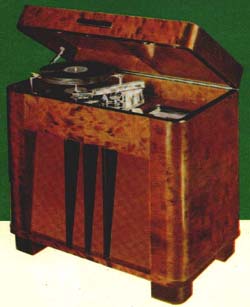
Luxor radiogram from 1939-40. Note the new construction of the sidepoles on the changer.
For the radio season of 1940-41 troubles seemed to come. Due to isolationist laws and governments commandeering factories for war production, some foreign radio manufacturers left the Swedish market, but those who had their own production or assembly facilities in Sweden stayed. Telefunken started using Luxor's record changers from 1941 and so did Orion. Philips had a large newly built factory in Norrköping where Philips, Dux, and later, Conserton products were manufactured. Garrard stopped making record changers, commandeered by government to make clockwork aerial bomb timing fuses until the end of the war.
As far as the original author knows, Philips still had no record changers of its own, but the original author missed a lot of brochures from Philips during the war years, so he is not really sure whether they stopped manufacturing radiograms or not. Several Swedish radio manufacturers didn't sell any radiograms at this time, and those who did sold them with Luxor changers. Others sold them without changers, stating that they offered a radio cabinet with a place for a record player or changer of the brand the customer would prefer. At this time those who wanted a record changer almost had to choose Luxor.
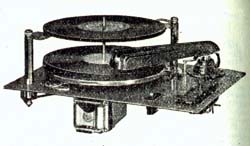
Paillard sidepole changer (Switzerland or France) was still available from mail order
company in 1942. Sold to be fitted in a cabinet, but never used by any commercial radio
manufacturer (as far as the original author knows).
Then another Swedish radio manufacturer suddenly gave Luxor some competition. AGA-Baltic, being part of the large AGA corporation (with plenty of financial and technical resources) had all the necessary knowledge and material to make its own record changer. In 1942 they dropped a bomb on the Swedish market. They had managed to build a record changer that could take 10" & 12" (25cm & 30cm) records intermixed.
It also featured pause and repeat functions. Pause could be set after each record, or after every second record, and it was adjustable from 5 seconds to 3 minutes. An extra set of control buttons was also placed to the left side of the original upright buttons, making it possible to operate the changer from outside the cabinet without raising the lid. AGA-Baltic used this feature on their radiogram "Orkester."

AGA-Baltic's first record changer of 1942, type V 42 M.
It must have been a setback for Luxor, because they started improving their sidepole changer and made sure customers heard about it. First they added a repetition function (1942) and then an automatic stop function (1943). Still the people at Luxor must have realized that AGA had left them far behind.
Luxor's sidepole changers still had the advantage of a low retail price (compared with AGA), but they could lose the important "top of the line" market. Using AGA changers in their classiest radiograms would have been a humiliation. The war kept Luxor from importing any foreign model. To make things worse, Telefunken and several other manufacturers abandoned Luxor's record changers for their radiograms, and used AGA-Baltic changers instead.

Luxor type AW with repeat and auto stop.
It took until 1944 before Luxor had the new changer ready. It was clumsy and complicated, but Luxor managed to build a machine capable of doing all that AGA's model did, and a few more tricks too. It was called the Luxor Robot, with model codes RBW (AC) and RBWL (AC/DC). It could change 10" & 12" (25cm & 30cm) records intermixed, it could make a pause after each record, or after every second record, and it could repeat any record, all just like the AGA changer. It was an ingenious apparatus but it was so expensive that Luxor had to keep the sidepole changer as a budget alternative.
The Luxor Robot had the progress-trip mechanism that always checked the normal forward movement of the pickup arm as the record played. When the pickup arm stood still, because the record was either finished or damaged, the change cycle was tripped. This made the machine able to detect the end of any record, no matter what kind of finishing groove it has (including none), and even if the record ends only halfway to the normal area where records\ end.
The progress trip was able to detect if a record was damaged so the needle got stuck playing the same passage over and over again, or if the center hole was worn out so the record was played off-center. Unfortunately, even though the Robot has a trip defeat for manual operation activated by moving the overarm over the controls, the progress trip prevents manually placing the tonearm while a stack is being played.
The original page author owns a Luxor Robot and reports that it works well, but during a record, a ticking is heard from the mechanism that can be very irritating when listening to a tune at low volume. This is a necessary part of the progress trip operation. Many changers with the velocity trip also produce a faint ticking once per turntable rotation. Usually when the changer is enclosed in a base or a cabinet, the ticking can not be heard.
The tonearm must not be interfered with and the control handle must not be moved during the change cycle. To clearly indicate when changer is in cycle, the Luxor Robot has a red lamp that shines when the user may not disturb the changer.
The control handle has the following functions:
- When the motor is off, the control handle is in the top row (farthest from the user).
- Moving the handle from the top row to the middle row turns on the changer motor.
- Moving the handle to the right column and releasing it starts a change cycle (reject). The handle then moves back to the center column in the same row under spring tension.
- At the end of the change cycle when the last record drops, the handle moves to the top row. On the next change cycle, the changer shuts off.
- Moving the handle to the top row tells the changer to shut off on the next cycle.
- Moving the handle to the middle column, then the top row, and then the right column causes a change cycle to immediately move the arm to the rest and turn off the motor.
- Moving the handle to center front sets the changer to repeat the playing record once.
- Moving the handle to center front and locking it with the tiny lever (seen to the right of the handle in the photo) sets the changer to repeat the playing record multiple times.
- Moving the handle to the left, and then to the front makes the changer play each record in the stack twice. The changer moves the handle back and forth between the left front and the left middle to keep track of how many times it has played each record. When the last record starts its second play, the handle moves to left back, shutting off the changer at the end of that play.
The silver knob with the pointer is the pause control.

Sales brochure for the record changer Luxor Robot RBW/RBWL of 1944.
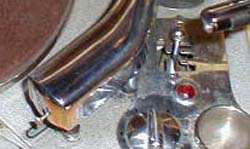
Note the red lamp below the control handle.
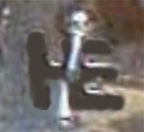
Luxor Robot control handle
Luxor had beaten AGA for the time being, but they had lost important market shares at a time when export was almost impossible. German radio manufacturer Telefunken didn't just sit back and watch when AGA and Luxor struggled in competition. In late 1943 they released their own record changer. It's rather likely that it was manufactured in Sweden and maybe even constructed in Stockholm. It seems to have a lot of control knobs and settings but since the original page author has never seen it in real life, he doesn't know much about its operation. But the brochure says that it is able to change 10" & 12" (25cm & 30cm) records intermixed.
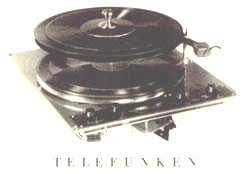
Telefunken record changer of 1943 with a semipermanent needle.
Late 1944 AGA released a new version of their record changer, but it wasn't such a bomb as before. It didn't really introduce any new features, but just some smaller technical improvements. The basic functions remained as before. The type was called V 42 S, pictured to the right.
Danish manufacturer Bang & Olufsen also sold these. The second picture at right is of the control panel of model G 64 A, which has the same controls the V 42 A has. The English meanings of the unfamiliar Danish words are as follows:
| Danish | English |
|---|---|
| Hver | Every |
| Hveranden | Every two |
| Mellem | Between |
| Pause | Pause |
| Pause Afbrudes | End Pause |
| Pause Indstilling | Pause Setting |
| Pause mellem hver plade | Pause between records |
| Pause mellem hveranden plade | Pause between every two records |
| Plade | Record |
| Repeter | Repeat |
| Skift | Change (Reject) |
| Skifter | Changer |
| Tryk knapperne helt i bund | Press buttons all the way down |
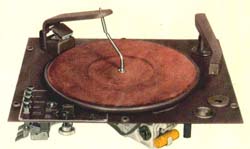

AGA controls
After the war
The war finally ended in 1945 and things could return to normal again. For Luxor, however, things would never really be the same. Their position as the only manufacturer of record changers in Sweden was gone. By the end of 1945 Telefunken released a new model called "Crypto". Just like AGA's changer it had 4 buttons to control it. It was probably manufactured in Telefunken's factory at Tellusborg, outside Stockholm.
The brochure says that it is able to handle records of different thickness and worn holes without difficulties. How that was supposed to work is not known.
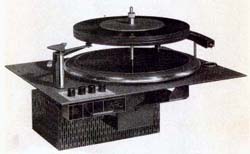
Telefunken Crypto of 1945.
Joboton made cheap 78-rpm changers. The changer shown at right has the upper part of the bent spindle attached to the arm that supports the records. The records are loaded with the arm raised. Joboton later made three-speed changers.
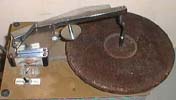
Another large radio manufacturer wanted a piece of the cake too. Philips started producing their own record changers in 1945 in Norrköping, Sweden. Their first record changer was 145 LV, and played 10" & 12" (25cm & 30cm) records intermixed. Like its competitors, this unit also featured pause and repeat functions, and it was controlled by buttons just like AGA and Telefunken.
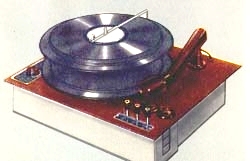
In 1946, Garrard was back on the Swedish market. They called their new changer "the Mixer" so it obviously must have been able to mix 10" & 12" (25cm & 30cm) records. It has no pause or repeat functions. This "Mixer" was model RC 60, but also appeared as RC 30 and RC 65. The overarm kept the records on the record shelf (at left, hidden behind records) which moved back and forth to detect the size of the bottom record and to push it off the spindle ledge.
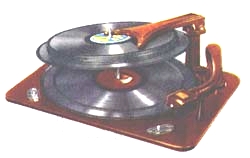
Garrard type RC 60, the "Mixer" ca 1946?
The top of the line Garrard changer, RC 70, was designed for the purist. It does not mix record sizes, but allows manual operation, which the other models above lack.
One would wonder why the top of the line was numbered RC 70 and not RC 100. The answer is that Garrard already had an RC-100 in 1938. It was a changer that played both sides of the records. They made their first production run to be sold in the USA, but the entire shipment was lost when a German U-boat sunk the ship carrying them. They never made any more because of the war. Only a few still exist.
Now there were so many record changer models on the Swedish market that one gets tempted to believe that such a small market couldn't possibly have room for any new types. Yet, new models were introduced. It was a matter of outrunning the competitors with new selling points.
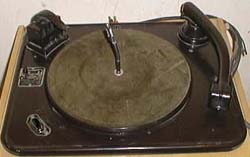
Garrard type RC 70 - no mix for the purist. Ca 1947?
Those companies producing their changers in Sweden did have one advantage. The government enacted restrictions for imported products and, at the same time, they encouraged Swedish companies to export as much as they could. Of course there were ways around those restrictions if it was considered necessary. For example it could be all right to import a record changer from abroad as long as it was fitted in a Swedish-built radiogram, so the actual effect on the industry was minor.
Luxor saw the chance of taking back parts of the Swedish market, and hoped to export to countries they had markets in before the war. In 1947 they released a whole new line of changers. They were basically old ideas with new styling. The new budget model SEW was almost identical to the improved sidepole changer of 1943. The second model in the line, DAW, was a sidepole changer of conventional type with a new pause function.
The third model was actually the only one with anything new. It was called ROW (or AC/DC version ROL). It was the new generation of the Luxor Robot. It didn't really feature any other functions than the original Robot, but it was a lot less clumsy and much easier to operate.
One would wonder why Luxor continued making sidepole (knife type) changers at the same time that American consumers were rushing to get rid of their knife-type changers. Most American manufacturers made push-type (single-shelf or overarm) changers after factories were released from wartime production.
The answer is that Sweden did not endure the wartime rationing the UK and US had to put up with. The rationing had three effects:
- Knife-type changers broke the brittle wartime records. These records were made of substitute materials because shellac was rationed.
- Knife-type changers require rounded record rims to work correctly. The sandwiching methods needed for making records with substitute materials required the rims of the records to not be rounded. This increased the probability of a knife breaking a record.
- Any person wanting a new record was required to turn in an old record to be allowed to buy the new one. The old records turned in were ground up, melted, and sandwiched with the substitute materials to make new records.
Swedish records were still made from good materials because there was no rationing in Sweden.
Since 78-rpm records by this time had been standardized to the two sizes 10" and 12" (25cm and 30cm) and the smaller odd formats hadn't been sold in Sweden for about 15 years (with an exception for some children's records) there wasn't really any obvious need for new features on the record changers. The top of the line machine could play both sizes intermixed, it could repeat each or every second record and pause of adjustable duration could be set also after each record or after every second record. It automatically shut off after the last record in stack had been played, and also allowed records to be played manually. What else could anyone want?

Luxor type SEW of 1947
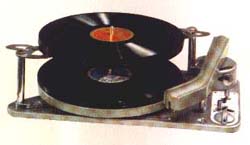
Luxor type DAW of 1947
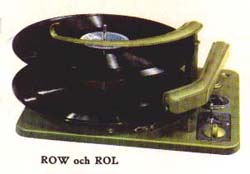
Luxor ROW / ROL of 1947 - The second generation of the Robot
It was necessary to introduce new models to stay in business. In late 1947, AGA released a new model. Type V 71 (or V 72 for AC/DC). They made many technical improvements, but most were not visible to the user. The scarcity of some materials during the war had forced AGA and other manufacturers to use inferior rubber and other substances. These were now replaced with more reliable parts. They also made cosmetic changes, as can be seen to the right.
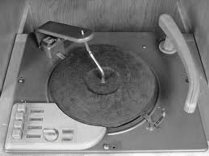
Philips had to follow the other companies, so by 1948 they also introduced a new model. It was called 148 V (148 VL and 148 VT also exist) and the buttons were replaced by two handles to control the changer functions. Philips had a rather large share of the Swedish radio market, so they had no problem selling their new changers in their own radiograms. Philips also controlled two other Swedish radio brands, Dux and Conserton, whose radiograms were also equipped with Philips record changers.
Telefunken, however, seems to have discontinued production of "Crypto" around 1948 and resumed using AGA-Baltic changers in their Swedish radiograms for reasons unknown to the original page author.
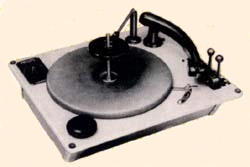
Speed Trouble
In 1948, American record company Columbia introduced the new microgroove vinyl record turning at 33&1/3 RPM. Other record companies were worried about what would happen. The ability to record almost half an hour on one side of a 12" (30cm) disc was rather attractive, and the sound quality was much better than on the old 78-rpm records.
When it seemed clear enough that the new format had come to stay in 1949, another American record company, RCA, introduced their idea of a record format: A vinyl disc of 7" (17cm) with a 1.5" (38mm) center hole and a speed of 45 RPM. This new format was supported by the jukebox manufacturer Seeburg, and that probably helped it to make a major breakthrough in the popular music market. At the same time, the 33-rpm LP format was ideally suited for symphonies, operas and other classical music. In the first couple of years, the impact of this was greater on the American grammophone industry than it was for European companies.
Swedish record changer manufacturers simply continued to produce slightly improved versions of their earlier 78 RPM changers. Luxor put Bakelite tonearms on their changers instead of the former metal ones, and AGA left off the pause function to come up with a budget alternative.
Also, Philips released a couple of new models called 149 V and 150 V. The vinyl records weren't yet a real threat, since no Swedish record company manufactured them.
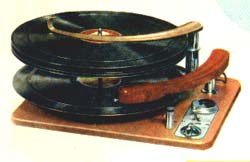
Luxor type RKW ca 1949-50. Similar to the ROW but with a new Bakelite tonearm.
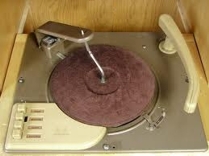
AGA type V 81 ca 1950. Identical with V 71 except for the missing pause function.
By 1950 Philips started to release microgroove records on the European market, and since they made record changers too, they had to release a new design at the same time. Their first 3-speed record changer was type 2975, introduced in the same year. It was able to play 10" and 12" (25cm and 30cm) records intermixed, or could be set to change 7" and 12" (17cm and 30cm) records intermixed. Records with 1.5" (38mm) center holes had to be played with an adapter. Different pick-ups were used for normal or microgroove records. These must be changed by hand.
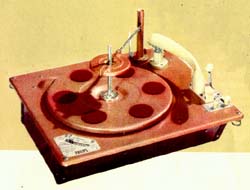
Just when the new record formats were confusing manufacturers of record changers another actor entered the Swedish market. It was the Stockholm-based company Centrum radio, who made their first changer in 1950. They introduced a 78 RPM, 10" and 12" (25cm and 30cm) intermix changer, acting as though nothing new had happened in the industry. It was model 531, and is rare today.
While the already established record changer manufacturers struggled with the problem of getting a 3-speed changer off the ground, Centrum chose to enter the field with an already outdated design. Perhaps they hoped that the new formats were just a short-lived gimmick, or maybe they had already invested so much money in this record changer that they simply had to try to get some of it back.
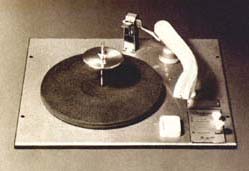
Centrum type 531.
Maybe the other companies hoped the new formats would flop as well. In 1950 Philips was the only European manufacturer with a 3-speed machine. In late 1951 AGA went first among the Swedish-owned companies with a 3-speed changer type V 203 S (AC/DC-version V 202 S, and V 201, which was not present in the brochures). It changed 10" and 12" (25cm and 30cm) records intermixed, but had to be manually reset to change 7" (17cm) records, like the Philips 2975. They totally omitted pause and repeat functions on this machine.

Luxor didn't have a solution ready for a 3-speed changer that could match their competitors. In late 1951 they took a 78 RPM changer, made it adjustable for 3 speeds, and added an extra tonearm to play microgroove records manually (note that many US manufacturers also did this in 1948 and 1949).
The tonearm for vinyl did, however, contain a smart new idea. It had a "rolling pick-up" that could be placed anywhere on the records surface. A small wheel takes the tonearm out to the edge of the record, and when the wheel falls off the edge of the record, it folds into the tonearm and the needle lands in the lead-in groove of the top record.
The vinyl playing arm is not locked in 78-rpm changer position, but at least there is no risk that it might be in the way for the changer tonearm, since it is placed on the opposite side of the turntable.
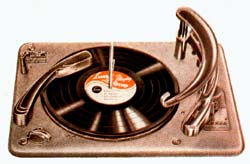
Luxor B 3 W, from ca 1951-52
Luxor even released a luxury version of this two-armed changer type RP 3 W which offers both pause and repeat functions. Notice that the control handle is the same as the one on model ROW.
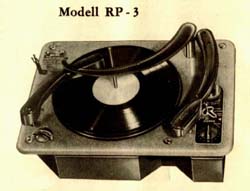
Luxor type RP 3 W also ca 1951-52.
By 1952, Centrum's 78-rpm changer 531 was rebuilt. The speed was adjustable for 33 and 45 RPM, as well as 78. Like Luxor they also added an extra tonearm to play microgroove records. But Centrum had no rolling pick-up, so they mounted the new arm under the 78 RPM one, so that it wouldn't obstruct the change cycle when 78 RPM records were used. The new 535 was sold only as an optional alternative to 531. These were likely Centrum's only (and rather short-lived) contribution to the era of record changers. It was in many ways outdated, since the 78 RPM pick-up still used screw-mounted steel needles. They were only sold in Centrums own radiogram stores. Even then some of these changers were replaced with another manufacturer's changer at the request of the customer.

Centrum type 535 sold ca 1952-54.
And now, 1953 (or late 1952), the time had finally come for Luxor to drop a bomb on the record changer market. They introduced the first model in the RT-series, the RTW 1. Records of any sizes between 6" & 12" (15cm & 30cm) could be played intermixed, as long as they were of the same speed. You didn't have to stick to one of the three standard sizes 7", 10" and 12" (17cm, 25cm or 30cm), since the changer had the rolling pickup finding the edge of only the top record in the stack on the turntable.
All you have to do is set the speed and start the machine. You don't even have to think about changing the needle between normal and microgroove tracks. That is automatically done when you set the speed for the records. The rolling pickup in combination with the automatic needle changing mechanism became a hit for Luxor, and these changers sold quite well in Sweden and abroad.
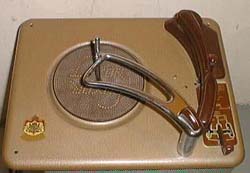
Luxor RTW 1 from ca 1953. The first model in the very successful RT-series. Later types had
larger and heavier turntables for better balance.
Free Import Again
At the end of 1954, the import restrictions were lifted, and foreign producers could compete on the same terms as Swedish ones. The radio manufacturers that didn't have any record changers of their own seemed to prefer Garrard again. Radiola and Kungs delivered their radiograms with Garrard RC 75. Centrum, who entered the record changer field just a few years earlier, now stopped production and used Garrard RC 75 too. Both size and speed had to be the same for all records in the stack.
Americans preferred the similar Garrard RC 80, although the American brands Webster-Chicago and Voice of Music outsold it.

Garrard type RC 75. Popular in the mid 1950s.
At the same time AGA dropped production of their changers and made a deal with the German manufacturer ELAC (Electroacoustic). Their record changer PW 6 S was mounted in AGA radiograms with the brand on the changer saying ""AGA made in Germany"". The changer could mix 10" and 12" (25cm and 30cm) records at 78 RPM or 33 rpm, or mix 7" and 12" (17cm and 30cm) records at 45 RPM. Later versions (PW 10, PW 100, and PW 200) had pause and repeat functions.
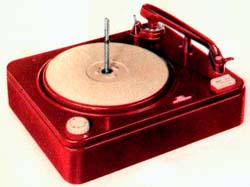
Telefunken seems to have stopped production of their "Crypto" changer in 1948 or 1949. They used AGA's record changers up to 1953, and then they started using Dual changers from Germany. Dual 1002 could take all standard sizes, with 10" & 12" (25cm & 30cm) intermixed, and 7" (17cm) changed either as only size or if put on top of a stack with larger records. Tjerneld also imported and used this model in their radiograms
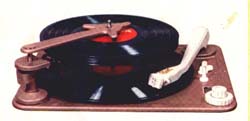
Then in 1955 Telefunken came back on the market with a record changer of their own brand. It was called Musikus D, and was now fitted in their radiograms as model TW 560. This changer was actually the Tri-O-Matic, made by the US company Voice of Music, but assembled in Germany from American parts, Telefunken put their own trademark on them. Pushbuttons were used on this model, as on their old model "Crypto". It could change 10" & 12" (25cm & 30cm) records intermixed. The changer feels all three sizes, but the feeling method used requires 7" (17cm) to be played separately (not mixed with other sizes). The REPEAT button could repeat a 10" or 7" (25cm or 17cm) record, but repeated a 12" (30cm) record as a 10" & (25cm) record.
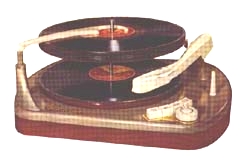
HMV also introduced a new changer in 1955. The original author doesn't know much about it. According to the brochure, it should be able to change all 3 standard sizes mixed. It is also equipped with a pitch control and a stroboscope pattern on the turntable. They were used in HMV radiograms and also sold as separate units. Although it may be a rather advanced design, no other manufacturer on the Swedish market appeared to use them.
Update: A video of this changer in use has appeared, dispelling some of the mysteries of this changer. It is called a TrioTrack, sold by a Dutch company, but the changer was made in Denmark. It has a unique method of feeling the size of the record and dropping it in one motion. The oval object at the sharp bend in the pickup arm just behind the cartridge head is the key component that makes this happen.
When the change cycle starts, the pickup arm moves to a point just outside the diameter of a 7" (17cm) record. It then rises to touch the underside of the bottom record on the spindle. The arm then moves in toward the spindle. If a record edge stops the arm, it stays there. If not, it moves outward and tries again near the edge of a 10" (25cm) record. If a record edge stops the arm there, the arm stays there. If not, it moves outward again and tries again at the edge of a 12" (30cm) record. Once it has found the edge of the bottom record, that little projection in the oval part of the arm pushes the bottom record to the left hard enough to cause it to drop from the spindle. After the record drops, the arm sets down at the proper place to play the size of the record it found.
After the last record, the pickup arm rises and then the power immediately shuts off. The arm stays over the end of the record.
Amazing! The pickup arm causes the record to drop! The page reviser actually had this same idea in the 1960s for use with the kind of size feeler found in the Collaro Conquest. But he quickly abandoned the idea, because the force needed to push off the record precludes putting precision bearings in the arm to minimize record wear.

The TrioTrack 600 changer used in some HMV radiograms. The little white ball under the back
end of the pickup head is the off-on-reject control.
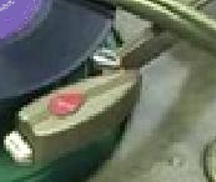
Close-up of the oval device in the pickup arm feeling the size of the record,
and about to push the record off of the spindle.
Philips record changers during the 1950s
Philips continued to introduce new record changer models too. The one that became most popular of them was AG 1000. It looks in many ways like 2975, and it has the same features. 10" & 12" (25cm & 30cm) records could be intermixed, or it could be reset to change 7" & 12" (17cm & 30cm) records intermixed. It could also repeat 7" (17cm) or 10" (25cm) discs but 12" (30cm) records were repeated as the size set for the smaller record size to be intermixed.
It was apparently introduced in late 1952. About two years later came the AG 1000 NS, and some three years after that, AG 1000 R. Differences between those types are minimal. Picture to the right shows AG 1000 S.
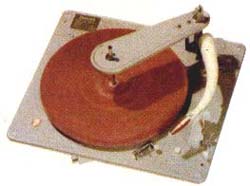
In 1953 Philips introduced a 4-speed record changer. AG 1002 V was built in Sweden. This was also the first Philips changer to take all 3 standard sizes intermixed in any order. The time of the changer cycle is constant, regardless of which speed the turntable is set for. It seems strange that this type didn't outrun Ag 1000, but it is very rare. It did cost much more than AG 1000, and it has no repeat function.
The intermix changing is made possible with the help of a feeler that is struck by a record falling down the spindle. A 12" (30cm) record pushes the feeler all the way down. A 10" (25cm) record pushes it down a little bit. A 7" (17cm) record does not touch the feeler. The mechanism detects the difference and determines the setdown point for the pickup.
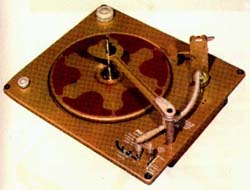
In 1954 Philips introduced a 3-speed all intermix changer that was called AG 1004. This model was probably made in Holland. It couldn't beat AG 1000 either, even though it was cheaper than AG 1000. It doesn't have the repeat function, but on the other hand, it was easily operated.
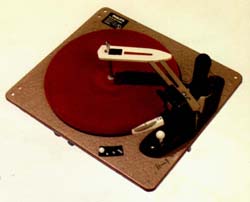
Another budget model was the type AG 1003, probably introduced in 1954 or 1955, It is able to change all standard sizes intermixed. If records are to be repeated or played with the short spindle, a special button is provided to set the record size with.

A Swedish-built budget model from ca 1956 also exists. It was called NG 1401, and plays records at all 4-speeds. It was controlled by buttons and had a special setting for manual playing of a record. On this model, one record size and speed is set for the whole stack. This model (or the related NG 1402) was often sold in Conserton radiograms, and the changer can also be seen marked with the Conserton name. Conserton was an old Swedish radio manufacturer that was at the time controlled by Philips.

In 1957, a 4-speed version of the AG 1003 was introduced. AG 1014 seems to have the same features as its predecessor, but adding the ability to play 16-rpm talking books. It was re-released in a slightly different version in 1958, mode; AG 1024. Picture to the right is of AG 1014.
There is a special button for single play and repeat on all three of these changers. Since the size feeler won't be struck a single record already on the turntable is played or repeated, the changer would ordinarily set the pickup down for a 7" (17cm) record. The button can tell the changer the correct size of the record in these cases.
If the overarm is removed, these changers can function as automatic single players, using the size button.

A special hi-fi version of the AG 1024 called AG 1105 (or AG 1005 if it was built into a radiogram) was also released in 1959. It had a built in stroboscope and a pitch control. Normally it was a record changer but it could also be used as an automatic single player. This was actually one of the last record changers made by Philips. Later models were automatic single players, though some models were able to operate as a record changer with some limitations.
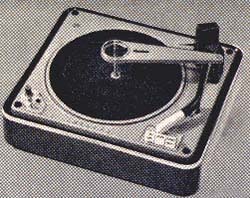
The German wonder conquers Sweden
Sweden became a wealthy country in the fifties and it showed in peoples demand for new home electronics. The radiogram had always been considered a luxury item before 1950 but now it was to become a natural part of most people's homes. While the market grew, the industry also could grow accordingly.
But in 1954, when import restrictions were lifted, a lot of foreign products also entered the Swedish market. German producers that sold products in Sweden before the war (such as Saba, Loewe, and Blaupunkt) now returned, and newcomers like Grundig, Graetz, and Körting came with them. None of these companies made their own record changers, but most of them sold radiograms. The changers they used were mostly Dual or Perpetuum-Ebner. Some producers sold them without changers too.
Graetz, Grundig, Schaub-Lorenz, and Blaupunkt used the Perpetuum-Ebner Rex changer. This changer played all sizes (including odd sizes) intermixed. The tonearm itself accurately measured the size of each record while it was lowered slightly from the stack before it was dropped.

Perpetuum-Ebner Rex A - ca 1956-58.
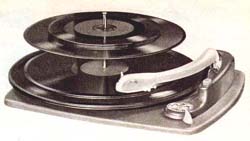
Perpetuum-Ebner Rex S Deluxe ca 1957-58. This model has 4-speeds.
Blaupunkt and Schaub-Lorenz used Garrard changers in some models, while Saba and Loewe normally featured Dual changers. Dual models 1003, 1004, 1005, and 1006 used feeler wheels in the arm (next to the pickup) to feel the record size. These were similar in operation to the Luxor rolling pickup, but did not operate except during a change cycle.
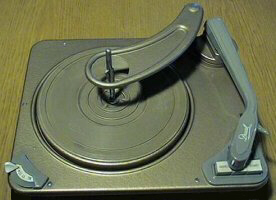
Dual 1004 ca 1956-59.
The last great years
Garrard finally released a record changer with a straight spindle and a feeler arm to detect the size of the records in the stack. It changes a mix of all 3 sizes as long as the largest records are put below smaller records in the stack. RC 110 appeared around 1956, and it was used by several Swedish radio manufacturers, among them Centrum and Radiola. This model was also used in some of Blaupunkt's radiograms. A few years later they introduced the type RC 120 which came in both 3 and 4-speed versions.

Garrard RC 110
In the 1960s, Garrard introduced the AT series that could take all three sizes mixed in any order. The 1000 series was similar, designed to be used in radiograms. These used a swinging feeler the falling record pushes away from the spindle. But Garrard also kept later versions of the RC 75, renamed the Type A, Type A Mk II, and A 70. These used the side shelf and the bent spindle to hold up records, and they could not change intermixed record sizes.

Garrard AT 60. Note the swinging feeler at the back.
Telefunken released a new model in 1958 called TW 501. It works like Musikus D but they replaced the pushbuttons with the knobs Voice of Music used on their other changers. It seemed to be a trend that the changers should be easily operated rather than loaded with extra features. Pause had disappeared already in the early fifties and now it seemed that the demand for repeating records had faded too. In 1959 Telefunken introduced a stereo changer called TW 562. Both of these were also designed and manufactured by American Voice of Music, but final assembly was in Germany. This may have been the last changer from Telefunken on the Swedish market.
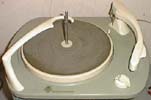
Telefunken TW 501 from 1958.
AGA introduced a new changer in late 1957 or early 1958, although it was actually another model from the German company ELAC, PW 9 S. The arm tip scanned the size of the record under the stack (like HMV 600, but the arm didn't cause the record to drop). It couldn't set down for any position. Just the three standard sizes could be changed, mixed in any order.
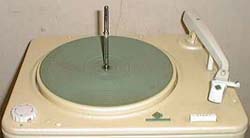
AGA (or ELAC) type PW 9 S
Finally, back were we started, with Luxor. The RT-series was improved by and by with a new model released almost every year. First they gave it a bigger and heavier turntable, then they introduced a microswitch instead of the original mercury switch, and then they changed the motor assembly so that it could be fitted in radiograms demanding less depth under the baseplate. Then there was time for a new pick-up type, then four speeds, and then stereo and so on.
The original page author doesn't know exactly how many different RT models Luxor made. He has seen the following: RTW 1, RTW 3, RTW 6, RTW 7, RTW 10, RTW 21, RTW 24, and RTW 242 S. (Models RTW 101, RTW 102, RTW 103, RTW 77, and RTW 210 are just variants for different table models). RTW 24 and RTW 242, introduced around 1962-64, no longer have either the rolling pickup or the automatic needle changing mechanism.
In the early 1960s, Luxor redesigned their changers to be more up to date for the hi-fi era, and the mentioned features, having served Luxor well for years, were now considered to be a source of rumble affecting the reproduction. Instead of the rolling pick-up, they introduced an arm with a brush with the roller that checked the size of each record before the pickup arm set down to play it.
The RT-series was very successful and exported to all parts of the world. It was also manufactured on license in some countries, notably the USA. Luxor discontinued record changer manufacturing in the mid 1960s.
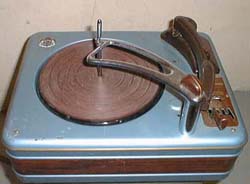
Luxor type RTW 101 a 4-speed changer ca 1958-59 in a base.
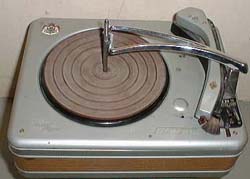
A 1960s version of the RTW-series called RTW 24. Uses a totally redesigned mechanism with
the rolling brush instead of the rolling pickup.
Record changers did of course exist also after the mid 1960s. Garrard, Dual, Perpetuum-Ebner, and BSR could be seen on the Swedish market at least until 1970 or so. With the death of the 10" (25cm) record came the end of changers able to take intermixed record sizes and changers able to hold more than six records. Users wanted automatic single play with a short spindle instead of size intermix.
On the pictured BSR 800 (and most other late 1960s and 1970s changers), a control knob selects one of the three standard sizes. These changers also can hold and change only six records. Some were even worse, combining the size and the speed on the same knob. They offered only a few of the many possible setting for use for automatic play.

A late-1960s changer, BSR 800.
Only Collaro continued to make changers that could take mixed sizes (larger records before smaller) and could hold 10 records. In most of these, the pickup arm touches the unplayed stack to feel the record size. Collaro continued to make such changers from 1955 until they stopped making record changers around 1993. The ones made before 1967 could change odd record sizes too.
These Collaro changers were used in most Magnavox (US) radiograms made after 1956 (as their Micromatic and Automatic series). They were also found in other manufacturer's products, and sold separately as components (such as PH 1252 at right).
The absence of Collaro from the original author's page is mystifying. Maybe very few Collaro products made it into Sweden where he could see them. But Webster-Chicago (one of the largest US record changer producers in the 1950s) also did not make it into the page. It is likely very few of those made it into Sweden as well.
Both the original author and the page reviser prefer those mechanical wonders of the early 1960s, the 1950s, or even earlier. An old radiogram with a record changer can still be purchased at an affordable cost at an auction, garage sale, pawnshop, or used merchandise store. It's getting difficult to find spare parts, but many of these machines still work, and if you are a little handy, you might be able to keep one playing for many years to come.
It may well serve as an alternative to a jukebox, and even though the original page author has acquired a jukebox, he won't stop using his radiograms. It's nice to play old tunes from old records and using old equipment. Keep playing!
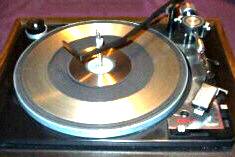
The mid-1970s Collaro PH 1252 has a precision arm.
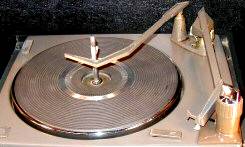
One of the last changers, a Magnavox Micromatic by Collaro.